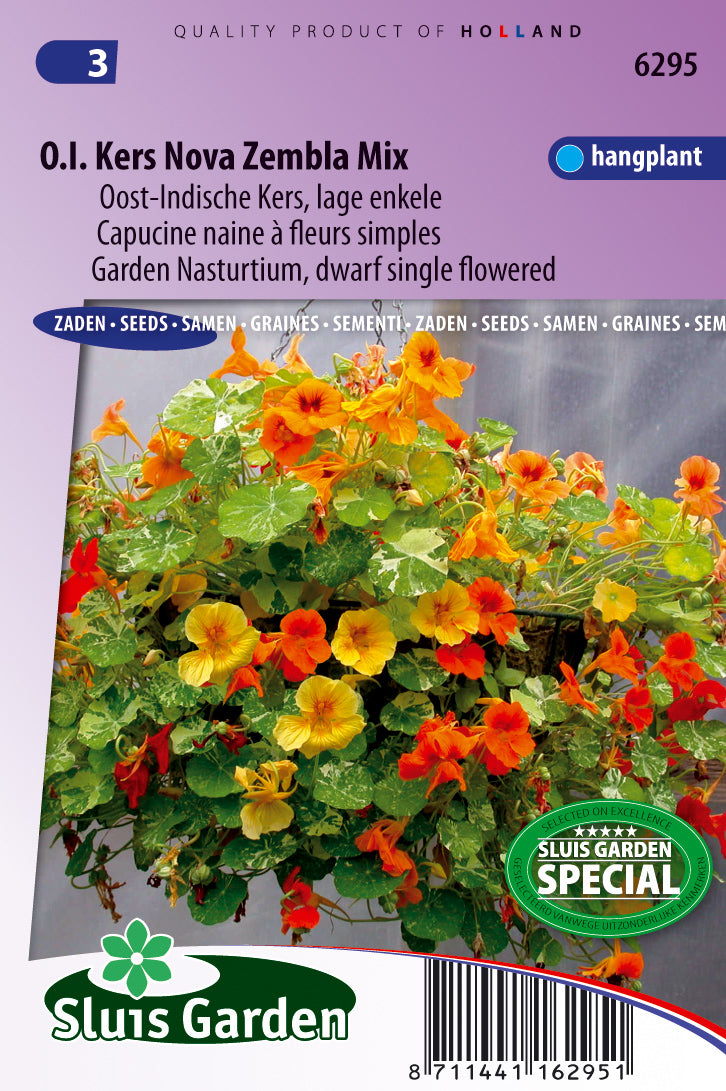1
/
of
1
Tropaeolum minus Nova Zembla
Tropaeolum minus Nova Zembla
Regular price
1.350 KWD
Regular price
Sale price
1.350 KWD
Unit price
/
per
Shipping calculated at checkout.
Couldn't load pickup availability
Growing Tropaeolum minus, commonly known as nasturtium, is relatively easy and can be a rewarding addition to your garden. Nasturtiums are known for their vibrant flowers and rounded leaves. Here's a guide on how to grow Tropaeolum minus:
**1. Planting Location:**
- Nasturtiums thrive in full sun but can tolerate partial shade. Choose a location with well-drained soil. They are not overly picky about soil quality and can adapt to various soil types.
**2. Planting Time:**
- Plant nasturtium seeds directly in the garden after the last frost has passed. Nasturtiums are sensitive to frost, so wait until the soil has warmed up in the spring.
**3. Planting Method:**
- Plant the seeds about 1 inch deep and space them 8 to 12 inches apart. Nasturtiums can have a spreading growth habit, so provide adequate spacing.
**4. Watering:**
- Keep the soil consistently moist during the germination period. Once established, nasturtiums are somewhat drought-tolerant. Water when the soil is dry to the touch.
**5. Soil Enrichment:**
- Nasturtiums prefer moderately fertile soil. Excessive fertility can lead to more foliage and fewer flowers. If your soil is rich, additional fertilization may not be necessary.
**6. Mulching:**
- Mulch around the plants to help retain soil moisture and suppress weeds.
**7. Support:**
- Nasturtiums are generally low-growing and don't require support. However, you can provide a small trellis or stakes if you want them to climb.
**8. Fertilization:**
- Nasturtiums are not heavy feeders. If your soil is poor, you can apply a balanced, all-purpose fertilizer sparingly.
**9. Pruning:**
- Pinch back the growing tips when the plants are young to encourage bushier growth. This can result in more flowers and a more compact habit.
**10. Deadheading:**
- Remove spent flowers regularly to encourage continuous blooming. This also prevents the plant from putting energy into seed production.
**11. Pest Management:**
- Nasturtiums are generally resistant to pests, but they can attract aphids. If needed, you can use insecticidal soap or a strong jet of water to remove aphids.
**12. Edible Flowers:**
- Enjoy the edible flowers in salads, where they add a peppery flavor. Make sure you are growing varieties specifically labeled as edible and have not been treated with pesticides.
Nasturtiums are known for their vibrant flowers and the ability to attract beneficial insects to the garden. They are versatile and can be grown in containers, hanging baskets, or directly in the ground. With their easy-going nature, nasturtiums can be a delightful addition to your garden, providing both ornamental beauty and edible blooms.
**1. Planting Location:**
- Nasturtiums thrive in full sun but can tolerate partial shade. Choose a location with well-drained soil. They are not overly picky about soil quality and can adapt to various soil types.
**2. Planting Time:**
- Plant nasturtium seeds directly in the garden after the last frost has passed. Nasturtiums are sensitive to frost, so wait until the soil has warmed up in the spring.
**3. Planting Method:**
- Plant the seeds about 1 inch deep and space them 8 to 12 inches apart. Nasturtiums can have a spreading growth habit, so provide adequate spacing.
**4. Watering:**
- Keep the soil consistently moist during the germination period. Once established, nasturtiums are somewhat drought-tolerant. Water when the soil is dry to the touch.
**5. Soil Enrichment:**
- Nasturtiums prefer moderately fertile soil. Excessive fertility can lead to more foliage and fewer flowers. If your soil is rich, additional fertilization may not be necessary.
**6. Mulching:**
- Mulch around the plants to help retain soil moisture and suppress weeds.
**7. Support:**
- Nasturtiums are generally low-growing and don't require support. However, you can provide a small trellis or stakes if you want them to climb.
**8. Fertilization:**
- Nasturtiums are not heavy feeders. If your soil is poor, you can apply a balanced, all-purpose fertilizer sparingly.
**9. Pruning:**
- Pinch back the growing tips when the plants are young to encourage bushier growth. This can result in more flowers and a more compact habit.
**10. Deadheading:**
- Remove spent flowers regularly to encourage continuous blooming. This also prevents the plant from putting energy into seed production.
**11. Pest Management:**
- Nasturtiums are generally resistant to pests, but they can attract aphids. If needed, you can use insecticidal soap or a strong jet of water to remove aphids.
**12. Edible Flowers:**
- Enjoy the edible flowers in salads, where they add a peppery flavor. Make sure you are growing varieties specifically labeled as edible and have not been treated with pesticides.
Nasturtiums are known for their vibrant flowers and the ability to attract beneficial insects to the garden. They are versatile and can be grown in containers, hanging baskets, or directly in the ground. With their easy-going nature, nasturtiums can be a delightful addition to your garden, providing both ornamental beauty and edible blooms.
Share

